Plant-based food and beverage company SunOpta (NASDAQGS:STKL) announced better-than-expected results in Q1 CY2024, with revenue down 18.3% year on year to $182.8 million. The company's full-year revenue guidance of $700 million at the midpoint also came in 2.3% above analysts' estimates. It made a non-GAAP profit of $0.02 per share, down from its profit of $0.04 per share in the same quarter last year.
SunOpta (STKL) Q1 CY2024 Highlights:
- Revenue: $182.8 million vs analyst estimates of $168.9 million (8.3% beat)
- EPS (non-GAAP): $0.02 vs analyst expectations of $0.02 (in line)
- The company lifted its revenue guidance for the full year from $685 million to $700 million at the midpoint, a 2.2% increase
- Gross Margin (GAAP): 17.4%, up from 15.2% in the same quarter last year
- Free Cash Flow was -$2.28 million compared to -$4.42 million in the previous quarter
- Sales Volumes were up 23.5% year on year
- Market Capitalization: $679.2 million
Committed to clean-label foods, SunOpta (NASDAQGS:STKL) is a sustainability-focused food and beverage company specializing in the sourcing, processing, and packaging of natural and organic products.
The company was established in the early 1970s as a small operation focused on processing and supplying organic and non-GMO soybeans. At the time, the health benefits of soy were gaining recognition, and SunOpta aimed to capitalize on its growing demand.
Over the years, SunOpta has expanded its offerings to include a diverse range of products, such as plant-based milk beverages, fruit-based snacks, organic ingredients, and specialty grains. SunOpta runs a vertically integrated model to ensure its rigorous quality standards are met, and its products are carefully sourced, processed, and distributed to meet the growing demand for natural and nutritious food options.
The company's commitment to wholesome foods resonates with health-conscious consumers, and it serves customers in North America, Europe, Asia, and beyond. Its plant-based beverage brands consist of SOWN, DREAM, and West Life and can be found at select retailers. SunOpta also partners with food manufacturers through its Sunrise Growers division to provide private-label and co-branded products.
Shelf-Stable Food
As America industrialized and moved away from an agricultural economy, people faced more demands on their time. Packaged foods emerged as a solution offering convenience to the evolving American family, whether it be canned goods or snacks. Today, Americans seek brands that are high in quality, reliable, and reasonably priced. Furthermore, there's a growing emphasis on health-conscious and sustainable food options. Packaged food stocks are considered resilient investments. People always need to eat, so these companies can enjoy consistent demand as long as they stay on top of changing consumer preferences. The industry spans from multinational corporations to smaller specialized firms and is subject to food safety and labeling regulations.
Competitors include private companies Organic Valley and Nature’s Path along with public companies Oatly (NASDAQGS:OTLY), Conagra (NYSE:CAG), and General Mills (NYSE:GIS).Sales Growth
SunOpta is a small consumer staples company, which sometimes brings disadvantages compared to larger competitors benefitting from better brand awareness and economies of scale.
As you can see below, the company's revenue has declined over the last three years, dropping 2.8% annually. This is among the worst in the consumer staples industry, where demand is typically stable.
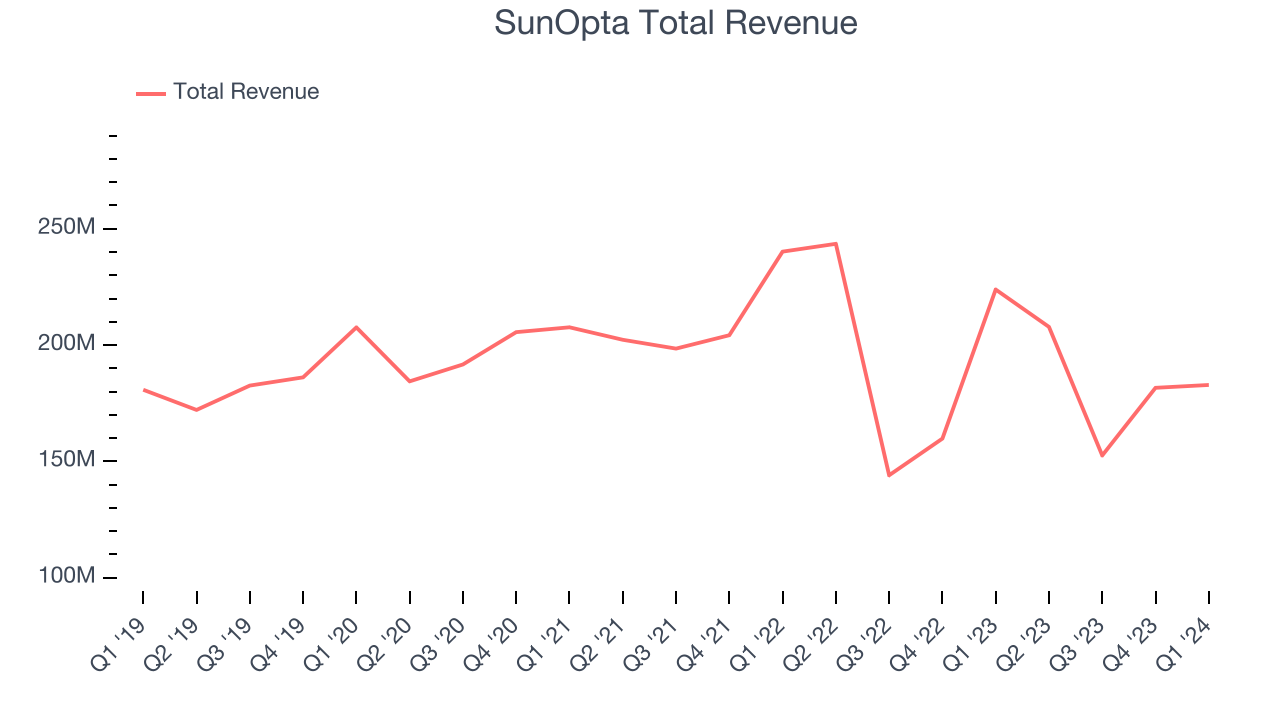
This quarter, SunOpta's revenue fell 18.3% year on year to $182.8 million but beat Wall Street's estimates by 8.3%. Looking ahead, Wall Street expects revenue to decline 3.4% over the next 12 months.
Gross Margin & Pricing Power
SunOpta's gross profit margin came in at 17.4% this quarter, up 2.2 percentage points year on year. That means for every $1 in revenue, a chunky $0.83 went towards paying for raw materials, production of goods, and distribution expenses.
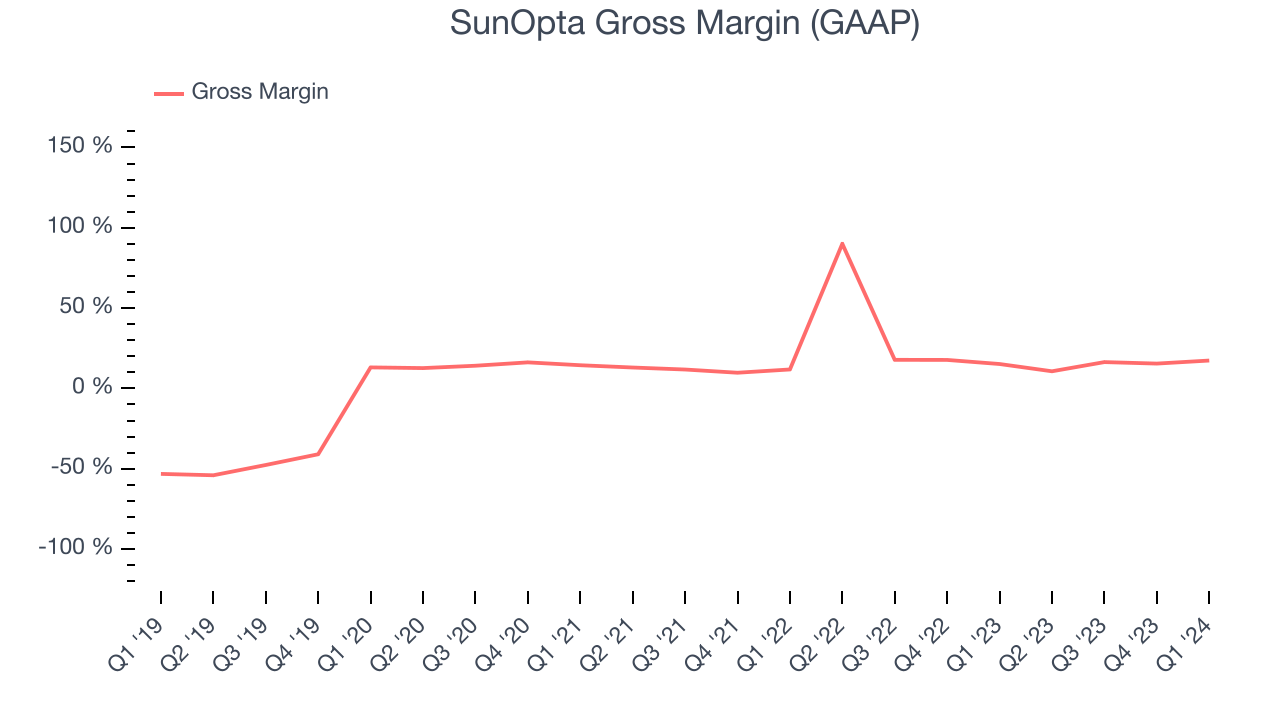
SunOpta has subpar unit economics for a consumer staples company, making it difficult to invest in areas such as marketing and talent to grow its brand. As you can see above, it's averaged a 27.7% gross margin over the last two years. Its margin has also been trending down over the last year, averaging 23.7% year-on-year decreases each quarter. If this trend continues, it could suggest a more competitive environment where SunOpta has diminishing pricing power and less favorable input costs (such as raw materials).
Operating Margin
Operating margin is a key profitability metric for companies because it accounts for all expenses enabling a business to operate smoothly, including marketing and advertising, IT systems, wages, and other administrative costs.
In Q1, SunOpta generated an operating profit margin of 5.6%, up 4.4 percentage points year on year. This increase was encouraging, and we can infer SunOpta was more efficient with its expenses because its operating margin expanded more than its gross margin.
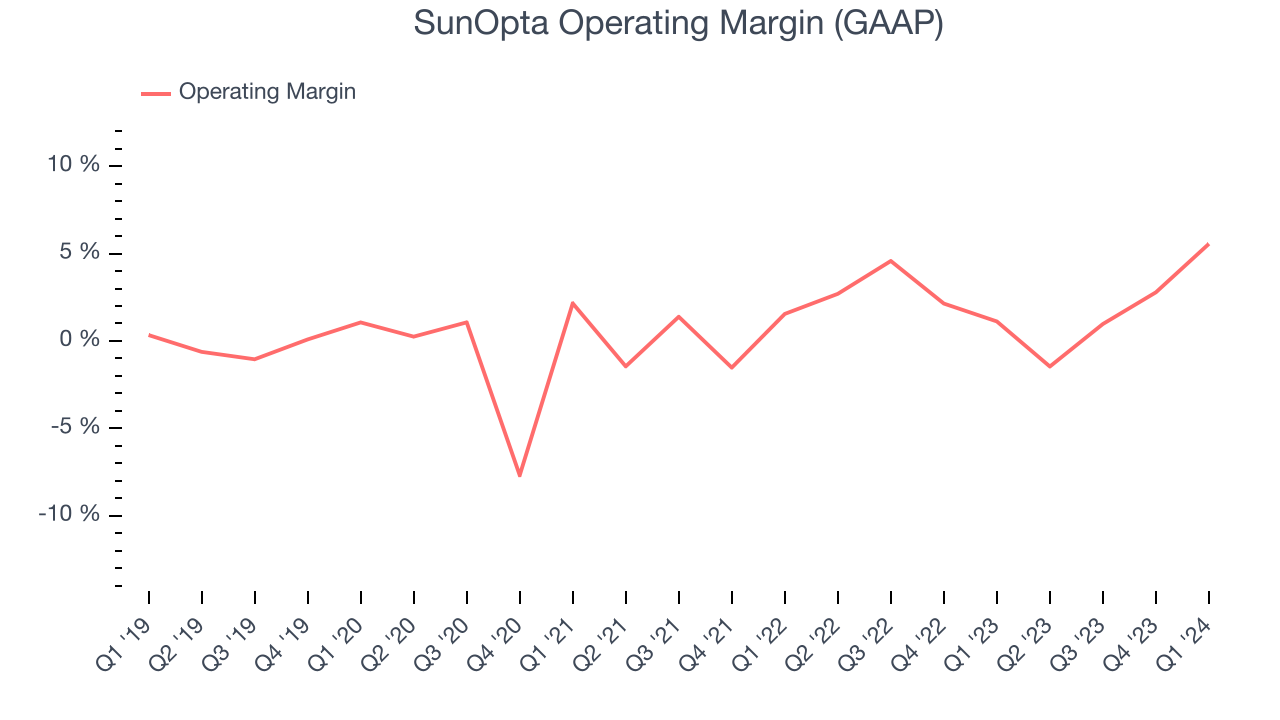 Zooming out, SunOpta was profitable over the last eight quarters but held back by its large expense base. It's demonstrated subpar profitability for a consumer staples business, producing an average operating margin of 2.2%. Its margin has also seen few fluctuations, meaning it will likely take a big change to improve profitability.
Zooming out, SunOpta was profitable over the last eight quarters but held back by its large expense base. It's demonstrated subpar profitability for a consumer staples business, producing an average operating margin of 2.2%. Its margin has also seen few fluctuations, meaning it will likely take a big change to improve profitability.EPS
These days, some companies issue new shares like there's no tomorrow. That's why we like to track earnings per share (EPS) because it accounts for shareholder dilution and share buybacks.
In Q1, SunOpta reported EPS at $0.02, down from $0.04 in the same quarter a year ago. This print beat Wall Street's estimates by 9.1%.
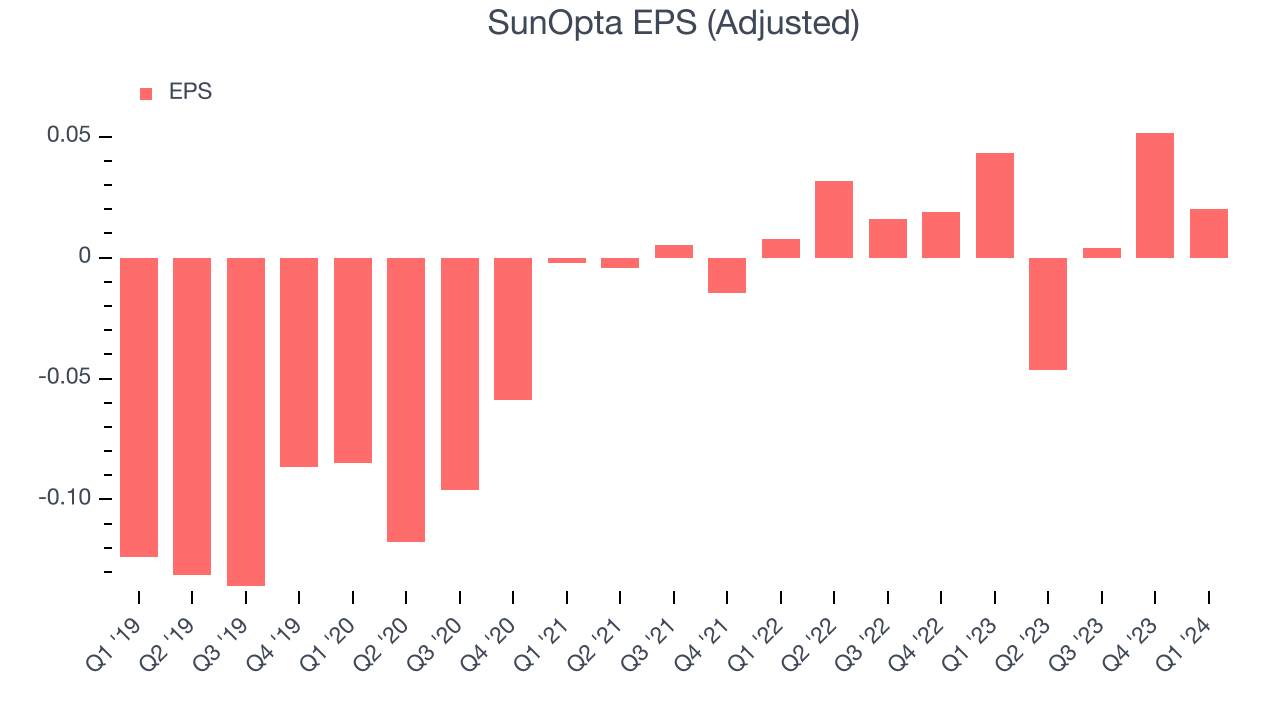
Between FY2021 and FY2024, SunOpta cut its earnings losses. Its EPS has improved by 28.2% on average each year.
Wall Street expects the company to continue growing earnings over the next 12 months, with analysts projecting an average 400% year-on-year increase in EPS.
Cash Is King
Although earnings are undoubtedly valuable for assessing company performance, we believe cash is king because you can't use accounting profits to pay the bills.
SunOpta burned through $2.28 million of cash in Q1, representing a negative 1.2% free cash flow margin. The company increased its cash burn by 89.6% year on year.
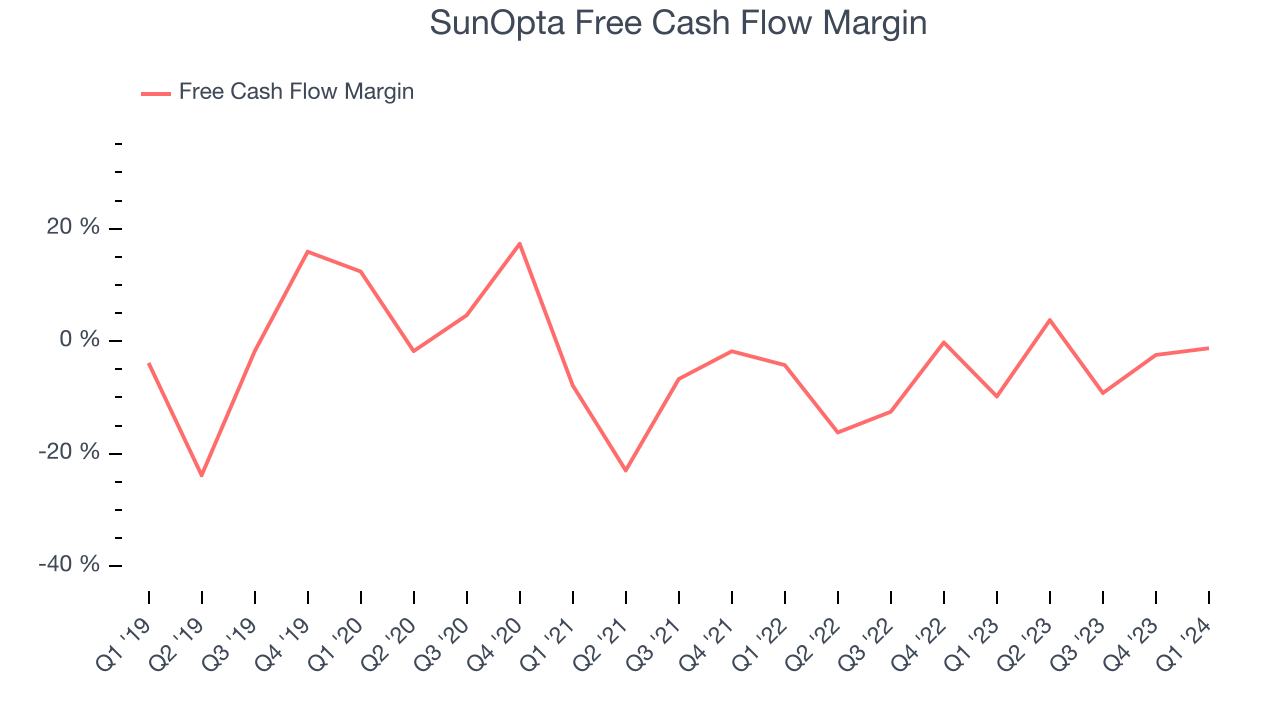
Over the last two years, SunOpta's demanding reinvestments to stay relevant with consumers have drained company resources. Its free cash flow margin has been among the worst in the consumer staples sector, averaging negative 6.2%. However, its margin has averaged year-on-year increases of 8.6 percentage points over the last 12 months, showing the company is at least improving.
Return on Invested Capital (ROIC)
EPS and free cash flow tell us whether a company was profitable while growing revenue. But was it capital-efficient? Enter ROIC, a metric showing how much operating profit a company generates relative to how much money the business raised (debt and equity).
SunOpta's five-year average ROIC was 1.1%, somewhat low compared to the best consumer staples companies that consistently pump out 20%+. Its returns suggest it historically did a subpar job investing in profitable business initiatives.
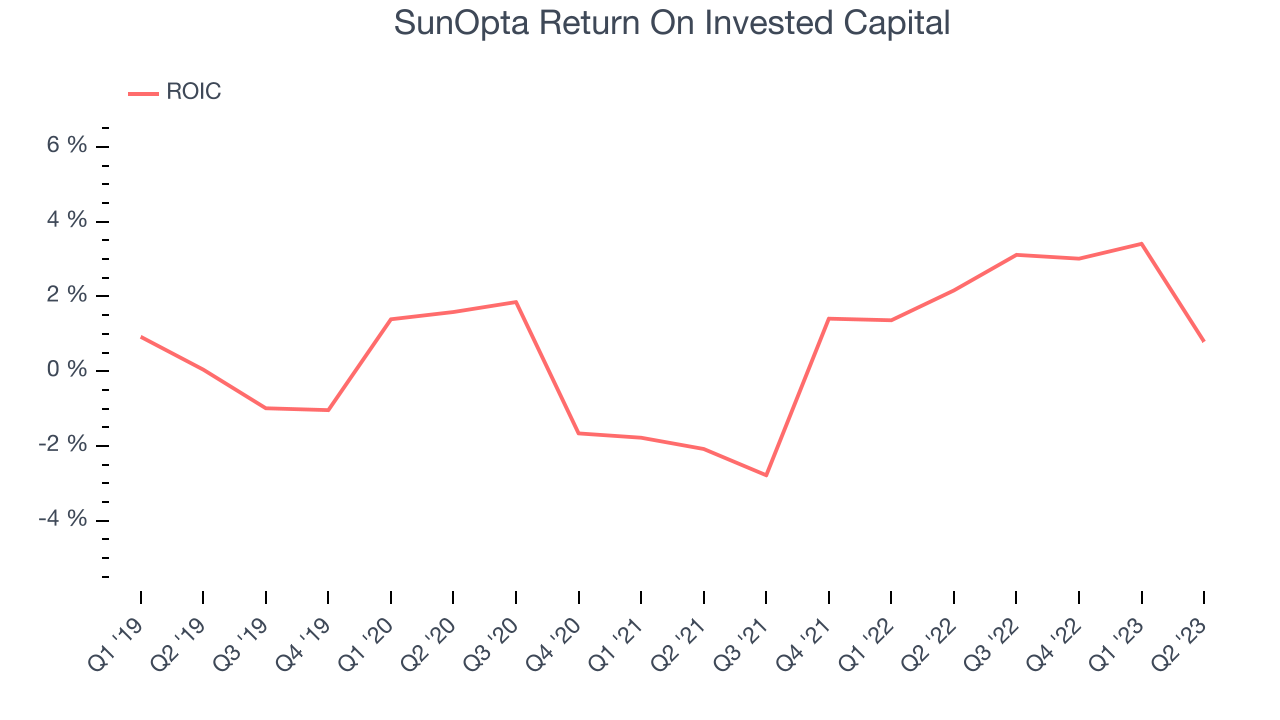
The trend in its ROIC, however, is often what surprises the market and drives the stock price. Over the last few years, SunOpta's ROIC averaged 2.6 percentage point increases. This is a good sign, and we hope the company can continue improving.
Balance Sheet Risk
Debt is a tool that can boost company returns but presents risks if used irresponsibly.
SunOpta reported $1.49 million of cash and $392.3 million of debt on its balance sheet in the most recent quarter. As investors in high-quality companies, we primarily focus on two things: 1) that a company's debt level isn't too high and 2) that its interest payments are not excessively burdening the business.
With $80.32 million of EBITDA over the last 12 months, we view SunOpta's 4.9x net-debt-to-EBITDA ratio as safe. We also see its $1.66 million of annual interest expenses as appropriate. The company's profits give it plenty of breathing room, allowing it to continue investing in new initiatives.
Key Takeaways from SunOpta's Q1 Results
We were impressed by how significantly SunOpta blew past analysts' revenue expectations this quarter. We were also glad its full-year revenue guidance came in higher than Wall Street's estimates. Zooming out, we think this was a fantastic quarter that should have shareholders cheering. The stock is up 3.7% after reporting and currently trades at $5.85 per share.
Is Now The Time?
SunOpta may have had a good quarter, but investors should also consider its valuation and business qualities when assessing the investment opportunity.
We cheer for all companies serving consumers, but in the case of SunOpta, we'll be cheering from the sidelines. Its revenue has declined over the last three years, and analysts expect growth to deteriorate from here. And while its projected EPS for the next year implies the company's fundamentals will improve, the downside is its cash burn raises the question of whether it can sustainably maintain growth. On top of that, its brand caters to a niche market.
SunOpta's price-to-earnings ratio based on the next 12 months is 38.8x. While we've no doubt one can find things to like about SunOpta, we think there are better opportunities elsewhere in the market. We don't see many reasons to get involved at the moment.
Wall Street analysts covering the company had a one-year price target of $9.57 per share right before these results (compared to the current share price of $5.85).
To get the best start with StockStory, check out our most recent stock picks, and then sign up to our earnings alerts by adding companies to your watchlist here. We typically have the quarterly earnings results analyzed within seconds of the data being released, and especially for companies reporting pre-market, this often gives investors the chance to react to the results before the market has fully absorbed the information.
